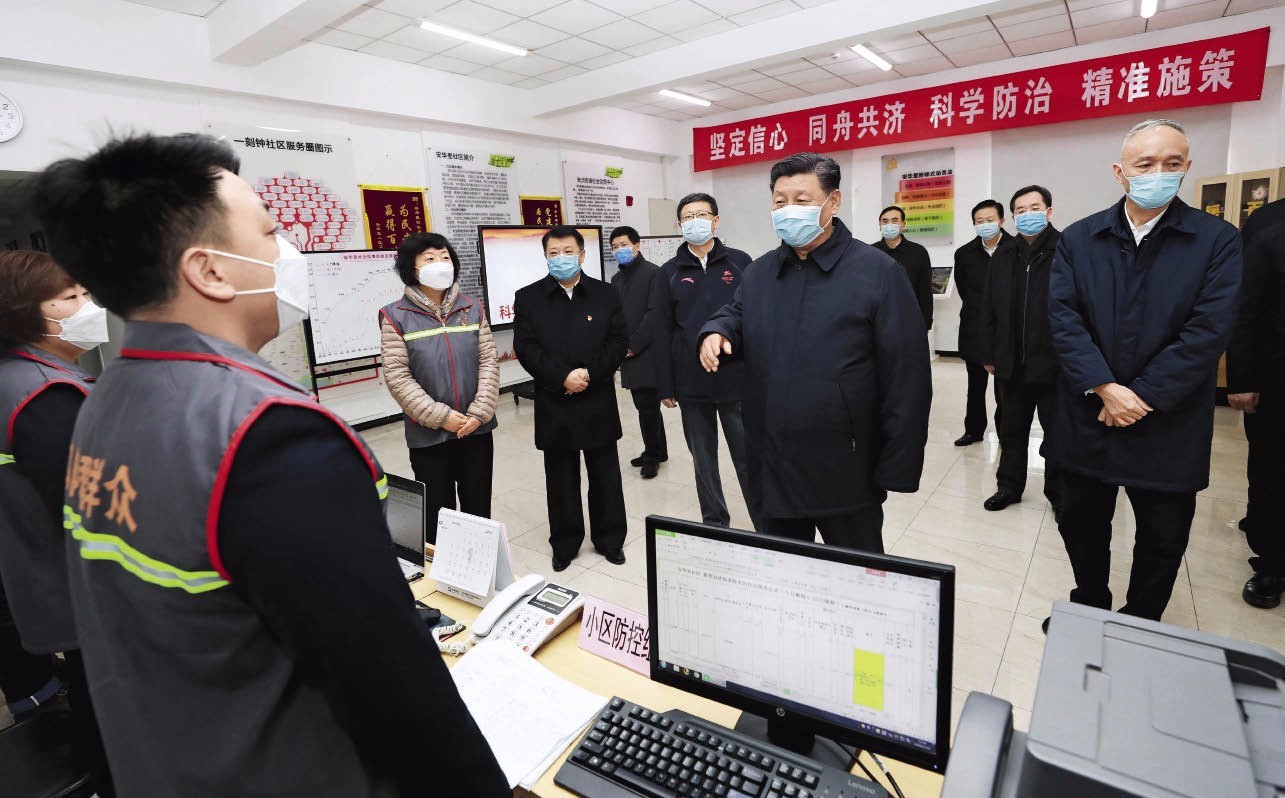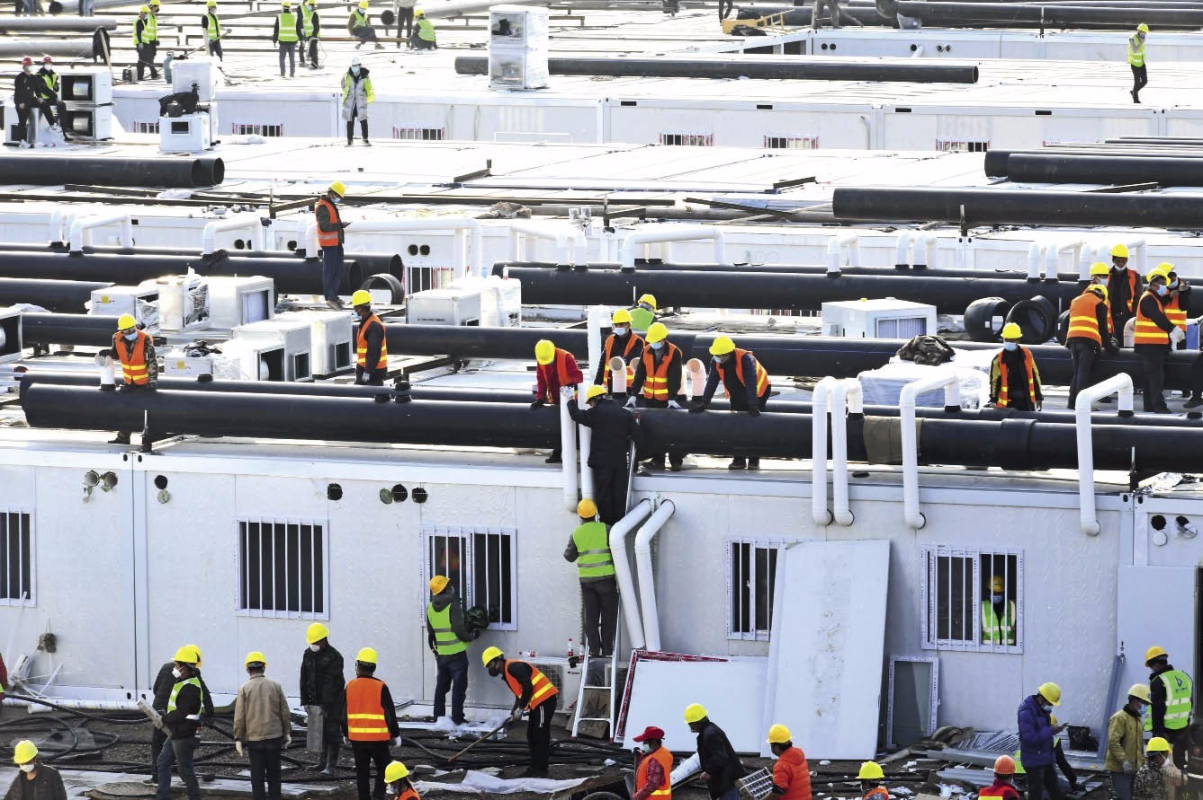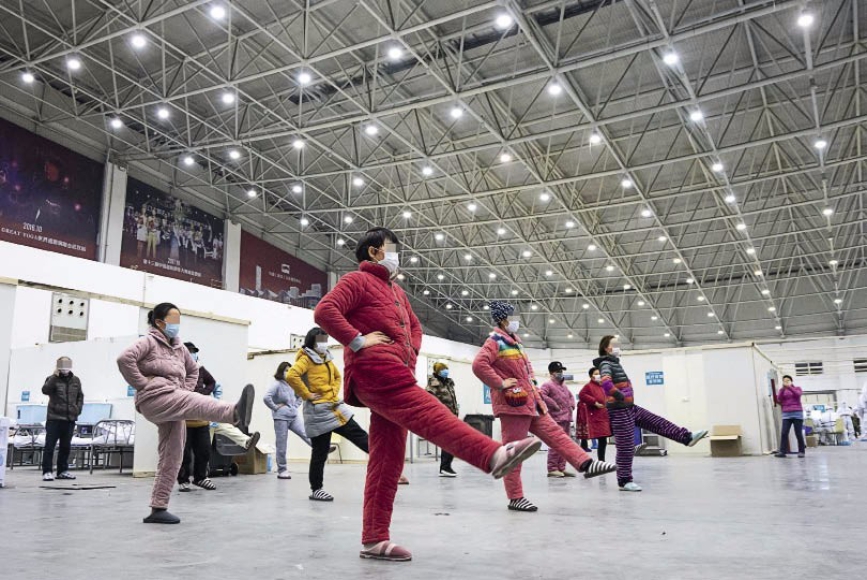
On February 10, Chinese President Xi Jinping visits Anhuali Community, Chaoyang District, Beijing to inspect the grass-roots epidemic prevention and control work.
A Comprehensive System for Prevention and Control
Since the outbreak of the epidemic, the Chinese government has attached great importance to mobilizing national forces to fight the epidemic, and release information on a timely, transparent, and responsible manner.
President Xi Jinping has given important instructions several times, and chaired the meeting of the Standing Committee of the Political Bureau of the CPC Central Committee to hear reports on epidemic prevention and control. China has set up a comprehensive and multi-level prevention and control system with the focus on Wuhan and Hubei Province. Under the unified leadership of the central authorities, with the active participation of all sectors of the society, the work has been carried out orderly and quickly.

The construction of the Wuhan Leishenshan hospital is underway on February 5.
At present, there are no specific drugs and vaccines effective for COVID-19 in the world. The traditional public health strategy is still the most effective measure to control the large-scale outbreak of the infectious disease. Judging from the current medical documents and research, people are generally susceptible to the novel coronavirus, so the only reliable and right way is to control the source of the infection and cut off the route of transmission. The unprecedented emergent public health measure the Chinese government has taken to lock down Wuhan in order to prevent the spread of the epidemic is the embodiment of China as a responsible country. It has been proven effective. Since the city’s lockdown, although the number of confirmed cases in China has been increasing, it must be noted that the majority of the cases are mainly concentrated in Wuhan. Most of the confirmed cases in regions outside Hubei Province have been caused by people who have been to Hubei lately or its residents who have traveled to other places.
Therefore, it is an effective measure to prevent the spread of the epidemic to strictly control the movement and travel of Hubei’s residents to all other places (including overseas). At present, all provincial governments have launched a high-level emergency response, taking effective actions and a variety of measures and technical means, closely checking people’s mobility and strictly controlling movement to timely spot cases and isolate those infected, thus preventing further infections. At the same time, the whole country extended the Spring Festival holiday, reducing the population flow to the lowest possible level, and required people from the affected areas to report cases and also take self-isolation measures for observation, thus effectively curbing transmission within the community.
If the Chinese government had not taken decisive and effective isolation measures, the novel coronavirus epidemic may have spread to other countries rapidly, causing a stronger impact on global health security, economy, and society. As Tedros Adhanom Ghebreyesus, Director-General of the World Health Organization (WHO), said at a press conference on January 30, “We would have seen many more cases outside China by now, and probably deaths, if it were not for the Chinese government’s efforts and the progress they have made to protect their own people and the people of the world.”

Patients at the Wuhan “Living Room” temporary hospital follow the instructions of the medical staff in doing breathing exercises on February 10.
All-round Support for Wuhan
Since its outbreak, China has mobilized the whole country to contain the epidemic.
First of all, the central authorities have maintained a high degree of vigilance against the epidemic. After the number of infected cases reached 200, the country began to activate a comprehensive response system to control the epidemic. On January 20, Chinese President Xi Jinping and Premier Li Keqiang asked governments at all levels to attach great importance to the epidemic situation, instructing the National Health Commission and local governments to establish an emergency response mechanism to deal with the epidemic. On January 25, the Central Leading Group on Responding to the Novel Coronavirus Pneumonia Outbreak headed by Premier Li Keqiang was established. On January 27, Premier Li Keqiang arrived in Wuhan to conduct on-site investigation and directed the fight against the epidemic on the frontline.
There are 72 grade-three class-A hospitals in Hubei Province, and 942 other various kinds of medical institutions. Wuhan has two large-scale general hospitals ranking among the top 10 in China, 27 grade-three class-A hospitals, and 229 other medical institutions. Under the unified deployment of the central government, dozens of medical teams from all over China rushed to Wuhan in batches to support the local medical efforts to contain the epidemic.
In order to meet the needs of patients’ treatment, China has built three special hospitals for acute infectious diseases in Hubei at an incredibly fast speed, among which the Dabieshan Regional Medical Center in Huanggang went into operation on January 28, which houses 1,000 beds; Wuhan Huoshenshan Hospital has 1,000 beds, and Leishenshan Hospital is equipped with 1,600 beds.
At the same time, since February 3, Wuhan has acted rapidly to convert existing venues, including gymnasiums and exhibition centers, into temporary hospitals to receive patients with mild symptoms. Within one day, 4,300 new beds were added in the three modified temporary hospitals for the centralized treatment of confirmed patients that had mild symptoms. “The use of temporary hospitals with large space is a major public health initiative taken by China,” said Wang Chen, vice president of the Chinese Academy of Engineering and Chinese Academy of Medical Sciences, a respiratory and critical medical expert, who once served as the leader of Beijing’s medical expert group during the SARS epidemic. He pointed out that the most urgent task at present is to curb virus transmission and proliferation after field investigation in Wuhan. Wang Chen indicated that temporary hospitals can receive a large number of patients with mild symptoms in a very short period of time at low costs. In the temporary hospitals, patients can get basic medical care. If the symptoms get worse, there will be medical staff who can identify and timely refer the patients to a regular hospital for intensive medical treatment. By February 22, the 13 operational temporary hospitals had 13,348 reception beds. Meanwhile, more temporary hospitals are still in the pipeline.
The rapid mobilization from the central level accelerated national support for Wuhan and Hubei Province, which are at the center of the epidemic. At present, the country has allocated urgently needed medical resources such as masks, protective clothing, and medicine to support Wuhan on a large scale.The Ministry of Industry and Information Technology also guided and called upon enterprises with medical material production qualification to restore production capacity as soon as possible. The Ministry of Finance allocated RMB 1 billion to Wuhan and Hubei for disease prevention and control; the central government also mobilized a large number of vegetables, food, and other necessities from other provinces to ensure the continuity of daily life of nearly 10 million people in Wuhan.
United as One to Combat the Epidemic
The work of epidemic prevention and control has also been accelerated across the country.
Local governments have all geared up to fully implement the prevention and control measures. The main tasks of the local government include spotting and treating the COVID-19 patients; identifying and urging those who come from Wuhan or have been to Wuhan before the lockdown of the city to undergo self-imposed quarantine for up to 14 days.
Compared with urban residents in China, the public health awareness of Chinese rural residents is relatively weak. During the Spring Festival, the visits between relatives and dinner parties greatly increased the chance of virus infection. In the case of seriously lacking necessary medical resources in rural areas, the local government requires people from epidemic-stricken areas to take measures of self-isolation for 14 days, vigorously publicizes public health knowledge, and urges people to reduce unnecessary excursions.
Due to the Spring Festival holiday, many factories that produce medical protective products have faced the constraint of lacking workers, raw materials, and finances. Local governments are required to coordinate resources in all aspects to ensure normal operation of factories. This inter-provincial support not only reflects the strong coordination of the central government, but also displays the common understanding of different regions about the epidemic.
The Chinese public had a very cheerless Spring Festival this year due to the outbreak of the epidemic. People had to cancel family gatherings and traveling, and try to reduce activities as much as possible. Despite all kinds of worries about the epidemic, Chinese people have shown their solidarity, optimism, and sobriety in face of the epidemic outbreak.
At the same time, China, in a highly responsible manner, has taken the initiative to carry out international cooperation, report the epidemic situation to the WHO timely, and share information. Many countries and the WHO have fully affirmed China’s effective and appropriate prevention and control measures, thanking the Chinese government for its cooperation and transparency, especially sharing the genetic sequencing of novel coronavirus with the international community, which reflects China’s leading role in the global public health field.
Surely, China still faces many difficulties and challenges in dealing with the current epidemic. Zhong Nanshan, head of the high-level expert group of National Health Commission, who once made outstanding contributions to the control and treatment of SARS 17 years ago, pointed out, “SARS lasted nearly six months 17 years ago, and now our country has made great progress in the prevention and control of major infectious diseases. We are confident in our ability to control the COVID-19 more effectively and restore normal social order as soon as possible.”
In the current situation, panic is more damaging than the epidemic itself. In fact, the epidemic is becoming preventable, controllable, and treatable, and the prevention and control measures taken by the Chinese government are very timely and effective. As many foreign friends have said, no country in the world can take prevention and control measures of such scale and intensity in such a short period of time, and it is very difficult for any country to have such mobilization ability as China.